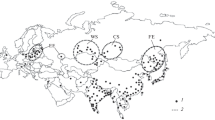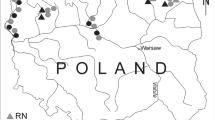Abstract
The genus Hydrocharis L. includes free-floating, occasionally rooted obligate pleistophytes and rooted hydrohelophytes, which are edificators and subedificators in freshwater vegetation communities. How ecologically similar are these closely related species? It has been established that Hydrocharis dubia (Blume) Backer. and H. morsus-ranae L. are facultatively freshwater alkaliphilic mesoeutrophic ortho- and mesoalluviophilic detrito- and psammopelophiles. H. chevalieri (De Wild.) is ecologically isolated; it is a freshwater acidoneutrophilic meso-, mesoeutrophic, ortho-mesoalluvialophilic species indifferent to the mechanical composition of bottom sediments. The coenocomplex of H. chevalieri is characterized by the abundance of helophyte communities; the key role in the composition of the coenocomplex of two other species is played by hydatophyte and pleistophyte communities. Communities with species of the genus Hydrocharis have simple synmorphology, a relatively high species richness, and a high proportion of low-abundance species.



Similar content being viewed by others
Notes
Plants of the World Online. Facilitated by the Royal Botanic Gardens, Kew. Published on the Internet; https://www.plantsoftheworldonline.org. Accessed February 12, 2022.
Guiry, M.D. and Guiry, G.M., AlgaeBase. World-wide electronic publication, National University of Ireland, Galway, 2022. https://www.algaebase.org. Accessed February 12, 2022.
GOST 3351-74. Drinking Water. Methods for Determining Odor, Smell, Color, and Turbidity, Moscow: IPС Izd. Standardov, 2003, p. 322.
Conservational Normative Document F14.1:2:3:4.121-97. Quantitative Chemical Analysis of Waters. Procedure of pH Measurement in Waters with the Potentiometric Method, Moscow: Minprirody Rossii, 2004
Quantitative Chemical Analysis of Waters. Method for Measuring the Mass Concentration of Aluminum, Barium, Beryllium, Vanadium, Iron, Cadmium, Cobalt, Lithium, Manganese, Copper, Molybdenum, Arsenic, Nickel, Lead, Selenium, Silver, Strontium, Titanium, Chromium, Zinc in Samples of Natural and Waste Water Atomic-Absorption Method with Electrothermal Atomization using an Atomic Absorption Spectrometer of Modifications MGA-915, MGA-915M, MGA-915MD. PND F 14.1:2.253-09, Moscow: Lyumeks-Marketing, 2013.
Methods of Quantitative Chemical Analysis. Collection of Measurement Techniques, Moscow: Akvilon, 2012.
Unified Methods of Water Analysis, Leningrad: Gidrometeoizdat, 1978.
Limnobium laevigatum, in Invasive Species Compendium, Wallingford, UK: CAB Int. https://www.cabi.org/isc/datasheet/ 115273. Cited June 8, 2022.
REFERENCES
Aleksandrova, V.D., Klassifikatsiya rastitel’nosti: obzor printsipov klassifikatsii i klassifikatsionnykh skhem v raznykh geobotanicheskikh shkolakh (Vegetation Classification: A Review of Classification Principles and Classification Schemes in Different Geobotanical Schools), Leningrad: Nauka, 1969.
Bobrov, A.A. and Chemeris, E.V., Syntaxonomic review of plant communities of streams, small and medium rivers of the Upper Volga region, Materialy VI Vserossiiskoi shkoly-konferentsii po vodnym makrofitam “Gidrobotanika 2005" (Proc. VI All-Russ. School-Conf. on Aquatic Macrophytes “Hydrobotany 2005”), Rybinsk: Rybinskii Dom Pechati, 2006.
Cao, Q.-J., Mei, F.-F., and Wang, L., Population genetic structure in six sympatric and widespread aquatic plants inhabiting diverse lake environments in China, Ecol. Evol., 2017, vol. 7, no. 15, p. 1. https://doi.org/10.1002/ece3.3141
Catling, P.M. and Dore, W.G., Status and identification of Hydrocharis morsus-ranae and Limnobium spongia (Hydrocharitaceae) in Northeastern North America, Rhodora, 1982, vol. 84, no. 840, p. 523.
Catling, P.M., Mitrow, G., Haber, E., et al., The biology of Canadian weeds. 124. Hydrocharis morsus-ranae L., Can. J. Plant Sci., 2003, vol. 83, p. 1001.
Chepinoga, V.V., Flora i rastitel’nost' vodoemov Baikal’skoi Sibiri (Flora and vegetation of reservoirs of Baikal. Siberia), Irkutsk: Inst. Geogr. Sib. Otd. Ross. Akad. Nauk, 2015.
Cook, C.D.K. and Lüönd, R., A revision of the genus Hydrocharis (Hydrocharitaceae), Aquat. Bot., 1982, vol. 14, p. 177. https://doi.org/10.1016/0304-3770(82)90097-3
Cook, C.D.K. and Urmi-König, K., A revision of the genus Limnobium including Hydromystria (Hydrocharitaceae), Aquat. Bot., 1983, vol. 17, p. 1.
Efremov, A.N. and Sviridenko, B.F., Resources of Stratiotes aloides (Hydrocharitaceae) in river valleys of the Middle Irtysh basin, Rastit. Resur., 2012, vol. 8, no. 2, p. 202.
Efremov, A.N., Grishina, V.S., Kislov, D.E., et al., The genus Hydrocharis L. (Hydrocharitaceae): distribution features and conservation status, Botanica Pacifica, 2020, vol. 9, no. 2, p. 83. https://doi.org/10.17581/bp.2020.09215
Efremov, A.N., Grishina, V.S., Toma, C., et al., Comparative morphology of the genus Hydrocharis L. (Hydrocharitaceae), Inland Water Biol., 2021, vol. 14, no. 6, p. 638. https://doi.org/10.1134/S1995082921060031
Ganie, A.H., Bashir, A., Khuroo, A.A., et al., A new record of an invasive aquatic plant Hydrocharis morsus-ranae (Hydrocharitaceae), reaching to the Kashmir Himalaya, J. Jpn. Bot., 2016, vol. 91, p. 100.
Haynes, R.R., Hydrocharitaceae, in Flora of Thailand, Bangkok, 2001, vol. 7, p. 365. iNaturalist.org https://www.inaturalist.org/home. Cited February 17, 2022.
Jacops, S.W.L. and McColl, K.A., Hydrocharitaceae, in Flora of Australia, vol. 39: Alismatales to Arales, Wilson, A., Ed., Melbourne: ABRS/CSIRO, 2011.
Kaplan, Z., Danihelka, J., Chrtek, J. Jr., et al., Distributions of vascular plants in the Czech Republic, Preslia, 2018, vol. 90, p. 425.
Katanskaya, V.M. and Raspopov, I.M., Methods of studying higher aquatic vegetation, in Rukovodstvo po metodam gidrobiologicheskogo analiza poverkhnostnykh vod i donnykh otlozhenii (Guidance on Methods for the Hydrobiological Analysis of Surface Waters and Bottom Sediments), Leningrad: Gidrometeoizdat, 1983.
Khitun, O.V. and Rebristaya, O.V., Vegetation and ecological and topological structure of the flora of the environs of Cape Khnorosale (arctic tundra of the Gydan Peninsula), Bot. Zh., 1998, vol. 83, no. 12, p. 21.
Kim, G.-Y. and Kim, J.Y., Standing crop distribution of aquatic plants in the west Nakdong River and Riparian Wetlands in the Nakdong River, Korean J. Ecol. Environ., 2014, vol. 47, no. 1, p. 62. https://doi.org/10.11614/KSL.2014.47.1.062
Kipriyanova, L.M., Aquatic and coastal-aquatic vegetation of the southeast of Western Siberia: syntaxonomy and ecological and geographical patterns of distribution, Doctoral (Biol.) Dissertation, Barnaul, 2019.
Krivokharchenko, I.S., Zhmylev, P.Yu., and Belyakova, G.A., Hydrócharis mórsus, in Biologicheskaya flora Moskovskoi oblasti (Biological Flora of the Moscow Region), Moscow: Argus, 1995, vol. 11.
Li, Zh.-Zh., Gichira, A.W., Efremov, A., et al., Plastome phylogenomics and historical biogeography of aquatic plant genus Hydrocharis (Hydrocharitaceae), BMC Plant Biol., 2022, vol. 22, p. 106. https://doi.org/10.1186/s12870-022-03483-2
Likhacheva, T.V., Ecological and phytocenotic patterns of distribution of vegetation cover of reservoirs in the Udmurt Republic, Doctoral (Biol.) Dissertation, Izhevsk, 2007.
Lim, J.-Ch., An, K.-Wh., Lee, Ch.-W., et al., Distribution patterns of hydrophytes by water depth distribution in Mokpo of Upo Wetland, Korean J. Environ. Ecol., 2016, vol. 30, no. 3, p. 308. https://doi.org/10.13047/KJEE.2016.30.3.308
Lobato‑de Magalhães, T., Murphy, K., Efremov, A., et al., How on Earth did that get there? Biogeographic and human influences on the global origins and distribution of aquatic macrophytes, Hydrobiologia, 2022. https://doi.org/10.1007/s10750-022-05107-0
Lolu, A.J., Shah, M.A., Reshi, Z.A., et al., Study on phytosociology and biomass changes (above-ground and below-ground) of emergent macrophytes in Hokersar wetland of Kashmir Himalaya, J. Environ. Sci., Toxicol. Food Technol., 2016, vol. 10, no. 11, p. 20.
Lubini, A., Association herbeuse aquatique à Hydrocharis chevalieri dans la région de Kisangani (Haut-Zaïre), Bulletin Nationale Plantentuin België, 1983, vol. 53, nos. 3–4, p. 331.
Makrofity—indikatory izmenenii prirodnoi sredy (Macrophytes—Indicators of Changes in the Natural Environment), Kiev: Naukova Dumka, 1993.
Murphy, K., Efremov, A., Davidson, T.A., et al., World distribution, diversity and endemism of aquatic macrophytes, Aquat. Bot., 2019, vol. 158, p. 103.
Nowell, A.A. and Fletcher, A.W., Food transfers in immature wild western lowland gorillas (Gorilla gorilla gorilla), Primates, 2006, vol. 47, p. 294.
Oki, Y., Integrated management of aquatic weeds in Japan, Proceedings of an International Seminar “Integrated Management of Paddy and Aquatic Weeds in Asia”, 1994.
Papchenkov, V.G., Rastitel’nyi pokrov vodoemov i vodotokov Srednego Povolzh’ya (Vegetation Cover of Water Bodies and Streams of the Middle Volga), Yaroslavl: Mezhdunar. Akad. Biznesa Nov. Tekhnol., 2001.
Passarge, H., Pflanzengesellschaften Nordostdeutsch-lands. 1. Hydro- und Therophytosa, Berlin: J. Cramer, 1996.
Pindel, Z. and Wozniak, L., Natural conditions for presence of some ornamental water and peatbog plants, Agricultura, 1998, vol. 70, p. 83.
Schweingruber, F.H., Kucerová, A., Adamec, L., and Doležal, Ji., Anatomic Atlas of Aquatic and Wetland Plant Stems, Cham: Springer Nat., 2020.
Siraj, S., Yousuf, A.R., and Parveen, M., Spatio-temporal dynamics of macrophytes in relation to ecology of a Kashmir Himalayan Wetland, Int. Res. J. Biochem. Bioinf., 2011, vol. 1, no. 4, p. 084.
Skwierawski, A. and Skwierawska, M., The role of Hydrocharitetum morsus-ranae in shaping the chemical composition of Surface Waters, Pol. J. Environ. Stud., 2013, vol. 22, no. 6, p. 1825.
Sosef, M.S.M., Hydrocharitaceae, in Flore du Gabon. vol. 50: Anacardiaceae, Hydrocharitaceae, Piperaceae, Leiden: Joseph Margraf, 2017.
Sviridenko, B.F., Flora i rastitel’nost' vodoemov Severnogo Kazakhstana (Flora and Vegetation of Water Bodies in Northern Kazakhstan), Omsk: Omsk. Gos. Pedagog. Univ., 2000.
Sviridenko, B.F., Mamontov, Yu.S., and Sviridenko, T.V., Ispol’zovanie gidromakrofitov v kompleksnoi otsenke ekologicheskogo sostoyaniya vodnykh ob"ektov Zapadno-Sibirskoi ravniny (The Use of Gidroagregativ in Complex Assessment of Ecological Condition of Water Objects of the West Siberian Plain), Omsk: Amfora, 2011.
Symoens, J.-J., Hydrocharitaceae, in Flore d’Afrique Centrale, Meise: Jardin Botanique Meise, 2015.
Temgoua, L.F., Momo Solefack, M.C., Mevoungou, M.-V., et al., Caractérisation de la végétation des clairières sur sol hydromorphe du Parc National de Lobéké, Est-Cameroun, Int. J. Biol. Chem. Sci., 2018, vol. 12, no. 3, p. 1364.
Toivonen, H., Changes in the pleustic macrophyte flora of 54 small Finnish lakes in 30 years, Ann. Bot. Fenn., 1985, vol. 22, no. 1, p. 37. http://www.jstor.org/stable/23725290
Tsuchiya, T., Growth and biomass turnover of Hydrocharis dubia L. cultured under different nutrient conditions, Ecol. Res., 1989, vol. 4, p. 157.
Vasilevich, V.I., On the methods of classification of vegetation, Bot. Zh., 1985, vol. 70, no. 12, p. 1596.
Vegetace Česke republiky. 3, Vodni a mokřadni vegetace (Vegetation of the Czech Republic. 3, Aquatic and Wetland Vegetation), Praha: Academia, 2011, vol. 1.
Vekhov, N.V., The expansion of the ranges of water vascular plants in the taiga zone of. Arkhangelsk region (Russia) as impacted by anthropogenic factors, Bot. Zh., 1994, vol. 79, no. 5, p. 72.
Yamalov, S.M., Golovanov, Ya.M., Baktybaeva, Z.B., and Petrov, S.S., Aquatic vegetation of the South Urals (Bashkortostan Republic). I. Classes Lemnetea and Charetea, Rastit. Ross., 2014, no. 24, p. 124.
Zhu, B., Ottaviani, C.C., Naddafi, R., et al., Invasive European frogbit (Hydrocharis morsus-ranae L.) in North America: an updated review 2003–2016, J. Plant Ecol., 2018, vol. 11, no. 1, p. 17. https://doi.org/10.1093/jpe/rtx031
Zutshi, D.P. and Vass, K.K., Ecology and Production of Salvinia natans Hoffim; in Kashmir, Hydrobiologia, 1971, vol. 38, no. 2, p. 303.
ACKNOWLEDGMENTS
We thank J.-P. Ghogue (independent researcher, Yaounde) for assistance in collecting the material.
Author information
Authors and Affiliations
Corresponding author
Ethics declarations
Conflict of interests. The authors declare that they have no conflict of interest.
Statement on the welfare of animals. This article does not contain any studies involving or animals performed by the authors.
Additional information
Translated by D. Zabolotny
Abbreviations: AD, author’s data; PC, projective cover.
Rights and permissions
About this article
Cite this article
Efremov, A.N., Sviridenko, B.F., Li, ZZ. et al. Genus Hydrocharis (Hydrocharitaceae): Ecology of Communities and Their Tolerance to Abiotic Factors. Inland Water Biol 16, 428–438 (2023). https://doi.org/10.1134/S1995082923030057
Received:
Revised:
Accepted:
Published:
Issue Date:
DOI: https://doi.org/10.1134/S1995082923030057




